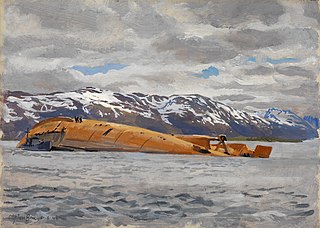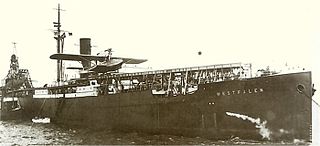 W
WSS Bärenfels was a German steam cargo liner that was launched in 1921 for DDG Hansa. In 1940 she took part in the German invasion of Norway and was sunk by Fleet Air Arm dive bombers. Her wreck was raised, and in 1941 she was returned to service. In 1944 a Royal Navy midget submarine sank her, killing 11 of her complement. In 1947 her wreck was raised to be scrapped, but while under tow she sank a third time.
 W
WOperation Catechism was a British air raid of World War II that destroyed the German battleship Tirpitz. It was conducted on 12 November 1944 by 29 Royal Air Force heavy bombers that attacked the battleship at its anchorage near the Norwegian city of Tromsø. The ship capsized after being hit by at least two bombs and damaged by the explosions of others, killing between 940 and 1,204 members of the crew; the British suffered no casualties.
 W
WThe Harbour explosion occurred in Bergen, Norway on 20 April 1944.
 W
WOperation Goodwood was a series of British carrier air raids conducted against the German battleship Tirpitz at her anchorage in Kaafjord in occupied Norway during late August 1944. It was the last of several attacks made by the Home Fleet during 1944 which sought to damage or sink Tirpitz and thereby eliminate the threat it posed to Allied shipping. Previous raids on Kaafjord conducted by Fleet Air Arm aircraft had involved only one air attack; in Operation Goodwood several attacks were made in a single week. The Royal Navy hoped that these raids would wear down the formidable German defences.
 W
WDeutsche Luft Hansa A.G. was a German airline, serving as flag carrier of the country during the later years of the Weimar Republic and throughout Nazi Germany.
 W
WSF Hydro was a Norwegian steam powered railway ferry that operated in the first half of the 20th century on Lake Tinn in Telemark. It connected with the Rjukan Line and Tinnoset Line, at Mæl and Tinnoset, operating between 1914 and 1944. The combined track and ferry service was primarily used to transport raw materials and fertilizer from Norsk Hydro's factory at Rjukan to the port in Skien. It was the target of a Norwegian operation on 20 February 1944, when resistance fighters sank the ferry in the deepest part of Lake Tinn in order to prevent Nazi Germany from receiving heavy water.
 W
WThe Liberation of Finnmark was a military operation, lasting from 23 October 1944 until 26 April 1945, in which Soviet and Norwegian forces wrested away control of Finnmark, the northernmost county of Norway, from Germany. It started with a major Soviet offensive that liberated Kirkenes.
 W
WOperation Mascot was an unsuccessful British carrier air raid conducted against the German battleship Tirpitz at her anchorage in Kaafjord, Norway, on 17 July 1944. The attack was one of a series of strikes against the battleship launched from aircraft carriers between April and August 1944, and was initiated after Allied intelligence determined that the damage inflicted during the Operation Tungsten raid on 3 April had been repaired.
 W
WThe NS monument, or Nasjonal Samling monument, was a Norwegian 9-meter-tall obelisk made from quartzite shale from Vågå. It was erected at Stiklestad in Nord-Trøndelag county in July 1944 and inaugurated by collaborationist Minister-President Vidkun Quisling. Since 1934 Quisling's Nasjonal Samling party had held a number of rallies at Stiklestad, in an attempt to link the party to Norway’s historic past. The NS monument took the place of the Olav's monument erected in 1807 in remembrance of Olav Haraldsson, who later became King Olaf II of Norway and received the epithet "Olaf the Holy." The Olav's monument was consequently placed in storage at Verdalsøra.
 W
WOperation Obviate was an unsuccessful British air raid of World War II which targeted the German battleship Tirpitz. It was conducted by Royal Air Force heavy bombers on 29 October 1944, and sought to destroy the damaged battleship after she moved to a new anchorage near Tromsø in northern Norway.
 W
WOperation Haudegen was the name of a German operation during the Second World War to establish meteorological stations on Svalbard. In September 1944, the submarine U-307 and the supply ship Carl J. Busch transported the men of Unternehmen Haudegen to the island. The station was active from 9 September 1944 to 4 September 1945 but lost radio contact in May 1945. The soldiers were capable of asking for support only in August 1945 and on 4 September, were picked up by a Norwegian seal hunting vessel and surrendered to its captain. The group of men were the last German troops to surrender after the Second World War.
 W
WOperation Paravane was a British air raid of World War II that inflicted heavy damage on the German battleship Tirpitz, at anchor in Kaafjord in the far north of German-occupied Norway. The attack was conducted on 15 September 1944 by 21 Royal Air Force heavy bombers, which flew from an airfield in the north of the Soviet Union. The battleship was struck by one bomb, and further damaged by several near misses. This damage rendered Tirpitz unfit for combat, and she could not be repaired as it was no longer possible for the Germans to sail her to a major port.
 W
WThe Petsamo–Kirkenes Offensive was a major military offensive during World War II, mounted by the Red Army against the Wehrmacht in 1944 in northern Finland and Norway. The offensive defeated the Wehrmacht's forces in the Arctic, driving them back into Norway, and was called the "Tenth Shock" by Stalin. It later expelled German forces from the northern part of Norway and seized the nickel mines of Pechenga/Petsamo.
 W
WOperation Tungsten was a Second World War Royal Navy air raid that targeted the German battleship Tirpitz. The operation sought to damage or destroy Tirpitz at her base in Kaafjord in the far north of Norway before she could become fully operational again following a period of repairs.
 W
WThe Dutch steam trawler Voorbode was a fishing vessel, until it was confiscated by the Germans during World War II and used for military transport. In April 1944, it was on its way from Oslo to Kirkenes when it faced mechanical problems, forcing it to seek repair in Bergen, Norway. Due to lack of control, the ship was allowed entrance to Bergen harbour loaded with 124,000 kg (273,000 lb) of explosives, even though the ship did not satisfy security regulations and should not have been allowed into major cities with this cargo.
 W
WThe Dutch steam trawler Voorbode was a fishing vessel, until it was confiscated by the Germans during World War II and used for military transport. In April 1944, it was on its way from Oslo to Kirkenes when it faced mechanical problems, forcing it to seek repair in Bergen, Norway. Due to lack of control, the ship was allowed entrance to Bergen harbour loaded with 124,000 kg (273,000 lb) of explosives, even though the ship did not satisfy security regulations and should not have been allowed into major cities with this cargo.
 W
WThe Western Front was a military theatre of World War II encompassing Denmark, Norway, Luxembourg, Belgium, the Netherlands, the United Kingdom, France, Italy, and Germany. World War II military engagements in Southern Europe and elsewhere are generally considered as separate theatres. The Western Front was marked by two phases of large-scale combat operations. The first phase saw the capitulation of the Netherlands, Belgium, and France during May and June 1940 after their defeat in the Low Countries and the northern half of France, and continued into an air war between Germany and Britain that climaxed with the Battle of Britain. The second phase consisted of large-scale ground combat, which began in June 1944 with the Allied landings in Normandy and continued until the defeat of Germany in May 1945.
 W
WSS Westfalen was a German ship launched on 14 November 1905 at Joh. C. Tecklenborg in Geestemünde.